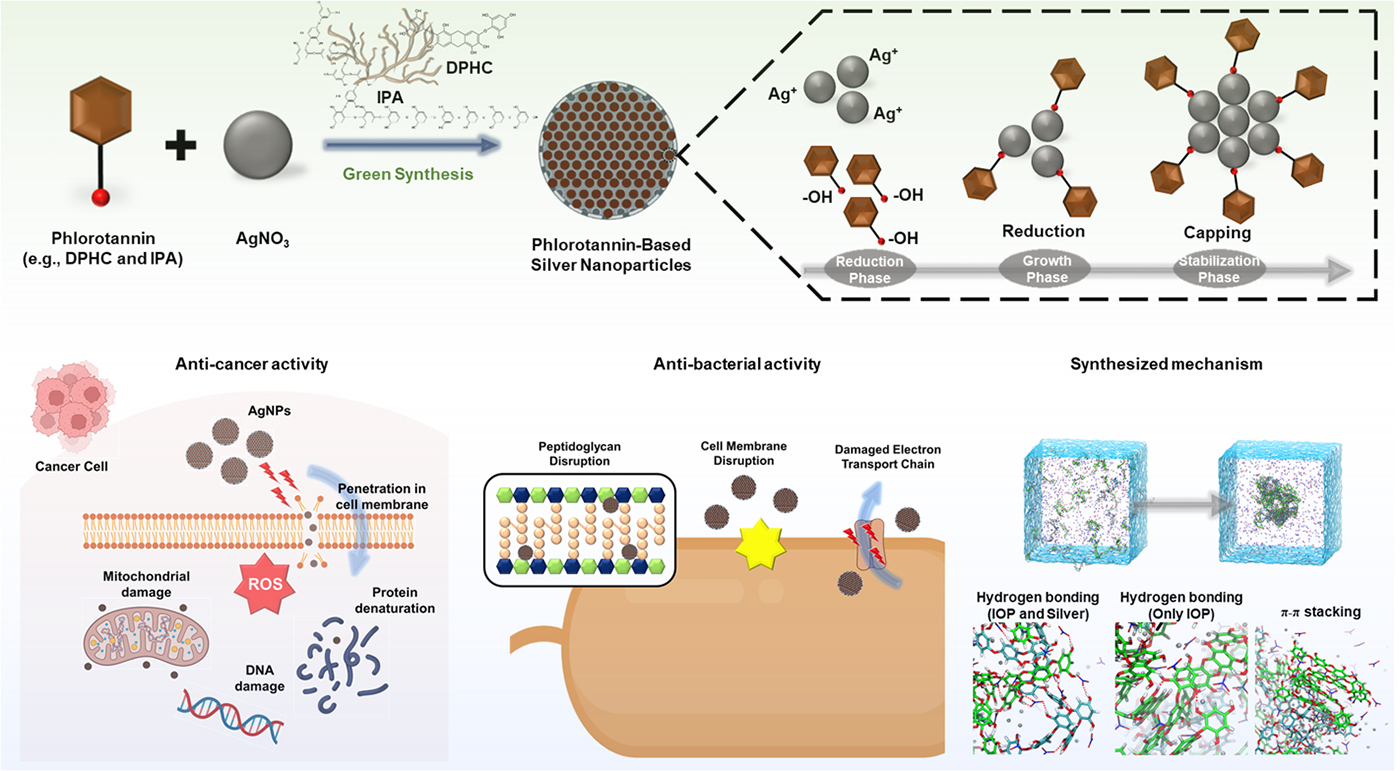일반
| 패 유래 물질 항암·항균 연구 '주목'(Research on Anti-Cancer and Anti-Bacterial Properties of Phytonutrients Gains ‘Attention’) | |||
| 작성일 | 2025-03-06 | 조회수 | 284 |
|---|---|---|---|
| 첨부파일 | |||
|
국립부경대 대학중점연구소, 해조류 항암·항균 연구 ‘주목’ - 패 유래 물질 활용해 기능성 은 나노입자 합성 … 국제저널 실려
△ 패 유래 플로로탄닌 활용 기능성 은 나노입자의 항암·항균 작용 이미지.
국립부경대학교 대학중점연구소인 해양바이오닉스융합기술센터(센터장 정원교) 연구팀이 해조류 유래 물질로 은 나노입자를 합성하고, 항암·항균 기능을 입증해 주목받고 있다.
연구팀은 갈조류 중 하나인 패에서 분리한 폴리페놀성 화합물 플로로탄닌을 활용해 기능성 은 나노입자(AgNPs)를 합성하고, 최적화된 합성 공정, 항암·항균 활성 평가, 분자역학 시뮬레이션 등을 통해 합성 메커니즘 연구결과를 제시했다.
최적화된 합성 공정을 통해 제작에 성공한 은 나노입자는 연구팀이 진행한 실험에서 우수한 항암 및 항균 효능을 나타냈다. 연구팀은 분자역학 시뮬레이션을 수행해 플로로탄닌과 은 나노입자 합성 과정을 분자 수준에서 예측하고, 나노입자 형성 과정과 pH 의존적 분자 거동도 규명했다.
연구팀에는 제1저자인 김남균 박사과정생(4차산업융합바이오닉스공학과)을 비롯, 교신저자인 정원교 교수(의공학전공)와 공동저자 이명기 교수(의공학전공), 이혜원 학생(의공학전공 4학년), Hadi Sedigh Malekroodi 석사과정생(4차산업융합바이오닉스공학과), 김영목 교수(식품공학전공), 오도경 박사 후 연구원(식품공학전공)이 참여, 공동 융합연구를 진행해 성과를 거뒀다.
이 연구결과를 담은 논문 ‘해양 유래 폴리페놀을 활용한 기능성 실버나노입자의 원팟 합성: 항암, 항균 및 MD 시뮬레이션(Harnessing marine-derived polyphenols for the one-pot synthesis of functional silver nanoparticles: Anti-cancer, anti-bacterial, and MD simulation)’은 재료소재 분야의 저명 국제학술지
연구팀은 이번 연구로 해양 천연물을 활용한 첨단 바이오 의료 소재 개발에 필수적인 데이터를 확보하고, 천연물 기반 나노소재 합성에 대한 핵심 기술을 제시함으로써 기존 기술적 한계를 극복할 수 있을 것으로 기대하고 있다.
한편, 이번 연구는 한국연구재단 대학중점연구소사업 및 한국연구재단 박사과정생 연구장려금 지원사업(연구책임자 김남균)의 연구비 지원을 받아 수행됐다. <부경투데이>
△ 연구팀 사진(왼쪽부터 김남균, 정원교, 이명기, Hadi Sedigh Malekroodi, 김영목, 오도경)
Pukyong National University Key Research Institute’s Research on Anti-Cancer and Anti-Bacterial Properties of Seaweed Gains ‘Attention’ -Synthesis of Functional Silver Nanoparticles Using Phytonutrient-Derived Substances Published in International Journal
The research team from the Marine Bionics Convergence Technology Center (Director Jung Won-Kyo), a key research institute of Pukyong National University, has gained attention for synthesizing silver nanoparticles (AgNPs) using seaweed-derived substances and demonstrating their anti-cancer and anti-bacterial properties.
The team used phlorotannin, a polyphenolic compound isolated from brown algae species, and synthesized functional silver nanoparticles (AgNPs). They presented the results of the synthesis mechanism through optimized synthesis processes, anti-cancer and anti-bacterial activity evaluations, and molecular dynamics simulations.
The silver nanoparticles successfully synthesized through the optimized process exhibited excellent anti-cancer and anti-bacterial effects in the experiments conducted by the research team. The team also performed molecular dynamics simulations to predict the phlorotannin and silver nanoparticle synthesis process at the molecular level, identifying the nanoparticle formation process and pH-dependent molecular behaviors.
The research team included the first author, Ph.D. candidate Kim Nam-gyun (Department of Industry 4.0 Convergence Bionics Engineering), corresponding author Professor Jung Won-Kyo (Department of Biomedical Engineering), co-author Professor Yi Myunggi (Department of Biomedical Engineering), student Lee Hye-won (4th-year Biomedical Engineering), Master’s student Hadi Sedigh Malekroodi (Department of Industry 4.0 Convergence Bionics Engineering), Professor Kim Young-Mog (Department of Food Engineering), and postdoctoral researcher Oh Do Kyung (Department of Food Engineering), all contributing to the successful collaborative interdisciplinary research.
The research paper titled ‘Harnessing marine-derived polyphenols for the one-pot synthesis of functional silver nanoparticles: Anti-cancer, anti-bacterial, and MD simulation’ was published in the prestigious international journal
Through this research, the team has gathered essential data for the development of advanced bio-medical materials using marine natural products and has provided key technologies for the synthesis of natural product-based nanomaterials, expecting to overcome existing technological limitations.
This research was supported by the National Research Foundation of Korea’s University Key Research Institute Program and the Doctoral Research Incentive Program (Research Leader: Kim Nam-gyun). <관련링크> |
|||
| 다음 | 바이오프린팅 신기술 최초 개발(World’s First Real-Time Elasticity Monitoring-Based Bioprinting Technology) |
|---|---|
| 이전 | 해양바이오닉스융합기술센터 대거 수상 '활약' |

